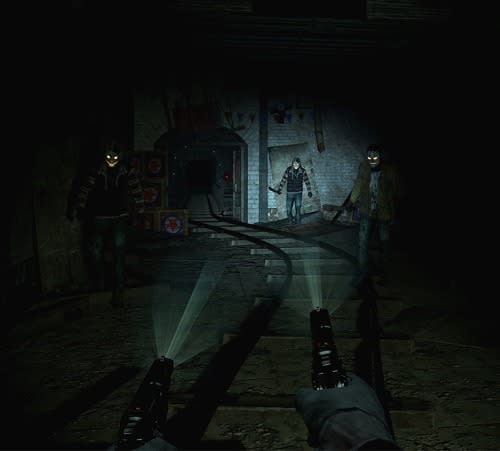Hands-on with Sony’s PlayStation VR: The virtual reality dark horse

It’s official, 2016 is the year of virtual reality. But you probably can’t afford it.
Systems like Oculus Rift (from Facebook) and HTC Vive (from HTC and Valve) are too pricey for many of us. That’s because in addition to the Rift and Vive’s already hefty price tags — they sell for $600 and $800 respectively — they also require you to have a high-end PC, which will cost you at minimum another $1,000.
But there’s a dark horse in the virtual reality wars: Sony’s PlayStation VR. Formally announced back in March, the PSVR is both less expensive than its rivals — bundles run $500 — and doesn’t require a hardcore PC to operate; instead, it runs off your standard PlayStation 4.
(The standard PSVR pack will cost $400, but it won’t include the Camera or Move controllers. To get those you’ll have to get the special pre-order bundle for $500 — or else you could presumably purchase everything separately.)
I spent some time with the PSVR during a recent press event in New York, and believe that, while the system could be the first VR headset for the masses, it still has a few drawbacks.
The hardware
I’ve been lucky enough to try out all three of the major virtual reality headsets, and while none of them are exactly uncomfortable, Sony’s is the least noticeable when you’re wearing it. It doesn’t feel heavy; after a bit, you almost forget it’s there.

The PSVR is also the easiest headset to put on. A button on the back lets you stretch out the headset’s band to quickly fit it around your noggin. It’s a much better system than the velcro-style straps used by the Rift and Vive.
A second button on the front of the PSVR lets you move the actual display portion of the headset closer to or farther from your face. This is by far my favorite feature of the headset, because it enables people who wear glasses (like me) to adjust the PSVR so it doesn’t mash your lenses against your face.

To track your head movements (and so adjust your perspective inside its virtual worlds), Sony’s PlayStation Camera follows nine large blue lights on the PSVR’s front, back, and sides. To sense your motions, the camera also tracks a large, light-up ball on top of the PlayStation Move controller and the light on the front of the standard PlayStation 4 controller.
The experience
Having used HTC’s Vive room-scale virtual reality system, Sony’s PSVR felt a bit restrictive at first. You can certainly move around a bit when playing standing games, and the Camera will still track the headset, but move too far, and it’ll stop tracking.
One of the onerous — though ultimately helpful — features of the Vive is that it has two tracking stations, which you position on opposite sides of your room. If, in turning around in a game, your body blocks the sensor in front of you, the one behind you will still have you covered.

That’s not the case with the PSVR. While playing Waltz of the Wizard, I turned away from the camera and the system had trouble picking up my controller. Facebook’s Oculus Rift, which also uses a sensor to track its headset and soon-to-be-released motion controllers, will presumably have to deal with the same issue.
That said, when I was facing the camera or turned to the side, the PSVR’s motion controllers were incredibly accurate. While playing Until Dawn: Rush of Blood, a horror shooter, my hand movements were perfectly replicated in the game. Given the way I was flailing all over the place any time a killer demon clown from Hell’s carnival jumped out at me, that’s pretty impressive.
Sony’s Move controllers are decent enough for interacting with PSVR’s virtual worlds, but I liked using the PS4’s controller a bit more. That’s by no means meant to be an indictment of the Move controllers, owing more to the fact that I have a PS4 and am incredibly comfortable using it. (The PS4’s is my favorite controller, period.)

My one gripe with the PSVR is that the headset’s resolution is a bit low compared to the Vive and Rift. There were times when I was playing games and trying to read small on-screen text, but couldn’t because it was too pixelated. That’s a letdown, especially when you’re dropping $500 on a headset.
The games
I played just a handful of games while demoing the PSVR, but I couldn’t help feeling as though they were more fleshed out than the games I played on the Vive. That could have more to do with the fact that the Vive’s biggest games — Tilt Brush, Job Simulator, and Fantastic Contraptions — are designed primarily to show off the Vive’s capabilities rather than provide a deep gaming experience.

I’m not saying the demos for Until Dawn, Rigz: Mechanized Combat League, or Waltz of the Wizard were totally engrossing, but they did draw me in more than Vive’s preliminary offerings.
The Rift, meanwhile, already has a handful of exciting games that will suck you in including EVE Valkyerie, Lucky’s Tale, and Adr1ft.

The outlook
Despite some hardware limitations, the PSVR is still every bit as fun to use as more powerful VR systems like the Rift and Vive. Whether that’s because VR in general is still new or because the PSVR is genuinely great remains to be seen.
Still, I love how ergonomically forgiving Sony’s headset is, and its $500 price tag isn’t painful either. Together, those two factors give PSVR much more mass appeal than its fancier kin. It’s just easier to swallow $500 for a PSVR (assuming you already have a PS4) than it is to shell out $1,600 to $1,800 to get a Vive or Rift (assuming you don’t already have a hardcore gaming PC).
Of course, these impressions are all still preliminary: between now and October, when the system is officially released, anything could happen. So stay tuned.
Email Daniel at dhowley@yahoo-inc.com; follow him on Twitter at @DanielHowley.

